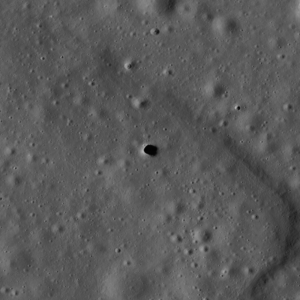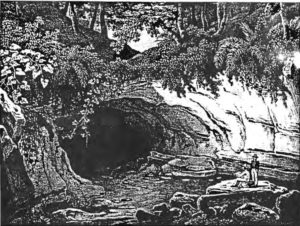Geologically speaking, volcanic activity rocks the house: land appears almost ex nihilo from volcanoes, spewed out as lava at (geologically) great speed, and occasionally explosively so. A fair few places on Earth (such as Mauritius) can only properly be grasped in terms of multiple lava onslaughts: studying these layers is arguably closer to codicology than to geography, if you like.
There are also many different types of lava: if you are an avid Scrabble-ist, you probably can at least spell aa (rough, rubbly lava), though you perhaps would be forgiven for not having used the eight-letter word pahoehoe (smooth lava, that can sometimes end up looking like coiled ropes as it cools). [Vulcanologists have countless technical terms for lava and lava-related features, *sigh*.]
However, what is far less well known is that as (typically pahoehoe) lava moves and cools, it often leaves behindvoids inside the lava flow: these can be long and thin (e.g. “lava tubes”), or small and round (“lava blisters”), or many other shapes. Hence the rocky basaltic landscape left behind by lava is defined not just by the overall topology of the rock itself as it moves and cools, but also by the eerie topology of the spaces left inside it.
For speleologists, these volcanic voids are wonderful and sublime: exploring and mapping the sinewy curve of a completely new lava tube is arguably just about as good as their hobby / profession gets. Lava caves are inhabited by bats, swiftlets, and all manner of curiously adapted species (including a number of Mauritian black magic altars). Yet it turns out that other, very different groups of people are also hugely interested in lava tubes…
As Below, So Above
Wonderfully, lava tubes and lava blisters are far from being a solely terrestrial phenomenon. Around 2009, a ‘skylight’ (a hole to the sky opening up at the top of a lava void) was discovered on the Moon, offering the theoretical possibility of ready-made shelter from radiation for future lunar astronauts, should (say) any future US President have broadly the same kind of scientific vision as John F. Kennedy once had (not that this seems particularly likely at the moment, admittedly). (Image from this AtlasObscura page):
And the same astro-vulcanological principles would seem to hold true for Martian geology as well. Future Martian astronauts not blessed with Matt Damon-ic fortitude may well end up sheltering inside the Red Planet’s lava tubes, wandering in awe through all the weird terraforming technology left there by ancient alien civilizations (hohum). 🙂 [“You are what you do“, indeed.] Here’s a picture courtesy of the European Space Agency, where the large dips would seem to be rilles (collapsed lava voids) and the black feature in the middle a skylight down to an intact lava tube.
Incidentally, there’s a GPR (ground-penetrating radar) rover called RIMFAX going to Mars soon, specific to look for voids: given that we have lava tubes on Earth that run for miles and miles, who knows what this robot will find there?
Looking For Lava Tubes…
Back on Earth, recent research suggests that there are many more lava tubes here than previously thought. Even though many groups of researchers want to know more about them, the practical problem is that that we typically only find these voids accidentally – one lava blister in the west of Mauritius was only discovered when a bulldozer driver bumped into it, knocking open the end of the blister.
And so I was pleased to find a paper where a large group of scientists developed a GPR system specifically for finding lava tubes and lava blisters non-invasively (and without the need for careless bulldozer driving). “Mapping the structure and depth of lava tubes using ground penetrating radar” (2005) by Miyamoto et al appeared in Geophysical Research Letters (Vol. 32, L21316, doi:10.1029/2005GL024159).
Having said that, Gaffney and Gater’s (2003) “Revealing the Hidden Past: Geophysics for Archaeologists” (which I finished reading this morning) shows a nice example of a void being found with normal GPR at 250MHz (p.173, of a railway tunnel), and also points (p.178) to Lorenzo et. al.’s (2002) paper “Selected Radar Images of Man-Made Underground Galleries” (Archaeological Prospection, 9(1), pp.1-8) as an exemplary study of looking for (admittedly) man-made tunnels and basements down to a depth of 7 metres. They conclude that GPR with a 100MHz centre frequency might well be the lower limit to use if you want avoid missing underground details.
But Why Lava Tubes, Nick?
If you’re wondering why I’m suddenly interested in lava tubes, the answer is actually painfully simple.
The most interesting section of Loys Masson’s copy of Le Butin’s papers that I blogged about recently runs as follows (my translation):
At the place indicated by my will, climb the river, and then climb the cliff eastward: twenty-five or thirty steps along according to the documents you will find corsair indicator marks to establish a circle of which the river is a few feet from the center. To the north and then four feet south you will find exactly the entrance to a cave once formed by an arm of the river passing beneath the cliff and blocked up by privateers to put their treasure in and this is the vault described by my will…
Prompted by insightful comments from Byron Deveson, it doesn’t take a huge leap of the geological imagination to see that what the writer was describing here was less likely to be an underground “river passing beneath a cliff” than a lava cave, lava tube or lava blister. And so for my proposed crowdfunding documentary, my plan is now to hire a suitable GPR rig, get myself trained up and go a-hunting on camera for any of these splendid lava void structures.
But how do I know there are any lava tubes on Mauritius at all? Well, that would be down almost entirely to the work of one determined individual… Greg Middleton. I’ll come back to his work in my next post, but to whet your appetite, here’s the earliest known drawing of a cave on Mauritius by the painter de Sainson (in D’Urville, 1830):



Goodness Gracious, Nick ! Lava tubes ! I was 10 years old when I was gifted a book (fiction, but based on actual geography, lava tubes and all). The location was the Hawaiian islands. When a boy of Hawaiian royalty reached maturity he had to prove his courage by sliding down the mountain’s lava tube (no mention of a surfboard) until he was ejected and propelled outward into the open air and into the sea some gawdawful distance below the tube’s opening.
So, you may be able to compare King Kamahameh’s adventures with those of the Mauritian’s. ?
beady
Hi Nick et al
My name is Philip McClelland. I have been a geophysicist for 30 years. Own my own company Ultramag Geophysics. I am a good friend of Byron Deveson’s.
I have only read this one blog so not quite sure of the full story.
We have developed a deep ground penetrating RADAR than can see up to 200m depth. Thsi is in a different league to conventional GPR.
Our DGPR works especilaly well in crystalline rock like basalt and would be used for mapping lava tubes to around 100m depth. To scan large areas, in the most cost effective manner, I would recommend a first pass by our senstive drone based magnetometers to locate the lava tubes then the DGPR to map the shape and depth. You can also use gravity meters.
WIth our DGPR, we have mapped voids (mine workings) in granites as small as 2m x 1m @ 60m depth which is unparallelled.
Beware – conventional GPR does not like clays, especially montmorillonite, which is derived from basalt. Conventional GPR usually only penetrates to 1m in these areas. In contrast we can punch though up to 30m of these kinds of clays.
We also do cutting edge LIDAR drones and a range of other geophysics.
Note that we do not have many details on the DGPR or drone technologies on our web site.
My contact is:
Australia
(02) 4948 8100
(0412) 525572 if you wish to discuss.
Most of the GPR data is available. We have satellites that provide this data. You might check with Stanford U. they are working on Mauritius. Your folks have found a lava tube that runs between Mauritius and Reunion islands.
xplor: errrrm… can you point me in the direction of any of those studies?
Philip McClelland: thank you very much for leaving a comment about your company’s very interesting technology! I’ll email you through a proper response later today…
@ Xplor: Do you have any info on the professors and/or their student teams? If so, I may be able to visit Stanford U, and possibly their library/archives. Meanwhile, Nick, I’ll do some look-ups at my local public libraries and our museums.
Meanwhile, CalFire and our Sheriff Deputies have caught the idiot who set off this latest drastic forest fire which has left some 400 people homeless. (Besides killing off many of our wildlife and birds.)
Gotta eat. Then I can continue to wash a very large sheep fleece ( I was part of the shearing team (ten years ago) which I have just discovered has been sitting in my basement since then. Ack ! I’ll be washing the fleece a small piece at a time; until our water wells (two of them) have refilled.
To say I’m ‘spinning around in circles” would be putting it mildly!
Beadier-eyed than usual (smoke everywhere we turn).
BD: you want to talk to the Department of Anthropology.
There are guys that use data to create 3D maps of anyplace in the world.
You may be looking on the wrong island, Mahe. xplor la Buse
Thanks, Xplor ! When my husband is done with the long drawn-out process of having cataract surgery (and can then chauffeur me to that part of the Bay Area). I shall try to contact Stanford U’s Public Relations team to see if I can peruse their library/Anthropology (and maybe geology) archives.
bd
The “DGPR” technology purported by Ultramag has been tested many times here in Australia, and it does not penetrate any further than a normal GPR. It’s not even an Australian system – it is simply a Russian system that they put new stickers on. My company conducted some tests last year and they could not generate depths any greater than normal GPR.